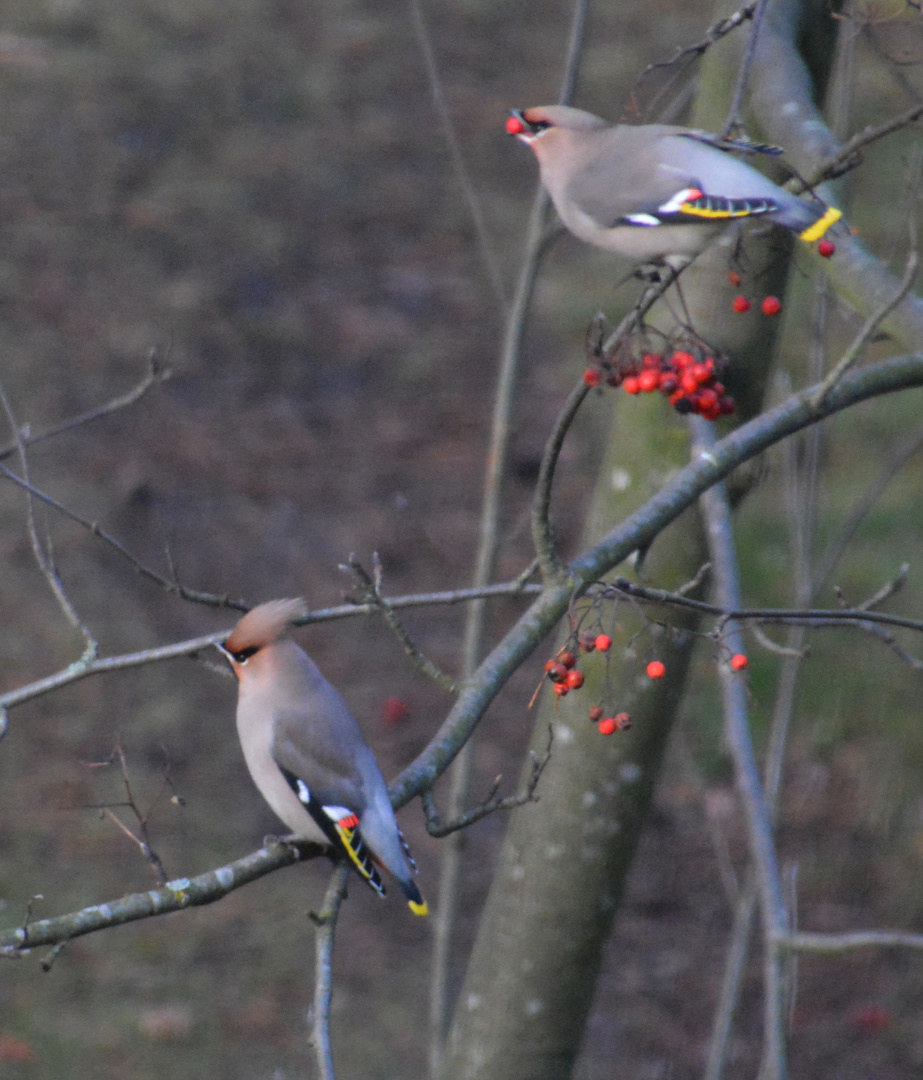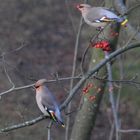The pair of The Bohemian waxwing
The Bohemian waxwing (Bombycilla garrulus) is a starling-sized passerine bird that breeds in the northern forests of Eurasia and North America. It has mainly buff-grey plumage, black face markings and a pointed crest. Its wings are patterned with white and bright yellow, and some feather tips have the red waxy appearance that give this species its English name. The three subspecies show only minor differences in appearance. Females are similar to males, although young birds are less well-marked and have few or no waxy wingtips. Although the Bohemian waxwing's range overlaps those of the cedar and Japanese waxwings, it is easily distinguished from them by size and plumage differences.
The breeding habitat is coniferous forests, usually near water. The pair build a lined cup-shaped nest in a tree or bush, often close to the trunk. The clutch of 3–7 eggs is incubated by the female alone for 13–14 days to hatching. The chicks are altricial and naked, and are fed by both parents, initially mostly with insects, but thereafter mainly fruit. They fledge about 14–16 days after leaving the egg. Many birds desert their nesting range in winter and migrate farther south. In some years, large numbers of Bohemian waxwings irrupt well beyond their normal winter range in search of the fruit that makes up most of their diet.
Waxwings can be very tame in winter, entering towns and gardens in search of food, rowan berries being a particular favourite. They can metabolise alcohol produced in fermenting fruit, but can still become intoxicated, sometimes fatally. Other hazards include predation by birds of prey, infestation by parasites and collisions with cars or windows. The Bohemian waxwing's high numbers and very large breeding area mean that it is classified as being of least concern by the International Union for Conservation of Nature.





















Klaus - Jürgen Miether 26/12/2019 16:59
Erittäin hieno valokuva, mutta myös erittäin vaikea ottaa kuvia.LG Klaus
JOKIST 21/12/2019 21:26
. . . . . das sieht wieder richtig klasse aus!Ingrid und Hans
Alfred Schultz 20/12/2019 12:49
Hope these birds are not hungry any more.Greetings - A.
GaWu 20/12/2019 9:06
Schön, wenn man sie so wildlife erleben kann - klasse inmitten der roten Beeren.Liebe Grüße Gabi
hajo peter. 18/12/2019 16:35
oh, schade das sie nicht ganz scharf geworden sind. lg hajoNorbert Kappenstein 18/12/2019 13:31
Prima erwischt hast du diese herrlichen Vögel, bei uns kommen sie leider nicht vor.LG Norbert
ralf mann 17/12/2019 22:10
Seidenschwänze! (Bombycilla garrulus). Greeting Ralfsabiri 16/12/2019 21:30
This are wonderfull Birds and a very good foto of them!Gerhard
Annamaria Regia 14/12/2019 11:06
congratulations for capturing the 2 beautiful and colorful little birdsgood weekend Annamaria
Robert Schüller 12/12/2019 11:54
Splendidly photographed, an eye catcher, Raimo.Bricla 10/12/2019 8:02
2008/09 lots of these birds visited our region. They look very interesting with their "cap".Wilfried Südheide 09/12/2019 23:29
Ein hübsches Motiv.Liebe Grüße
Gernot Disselhoff 09/12/2019 19:43
Wunderschön LG gernot